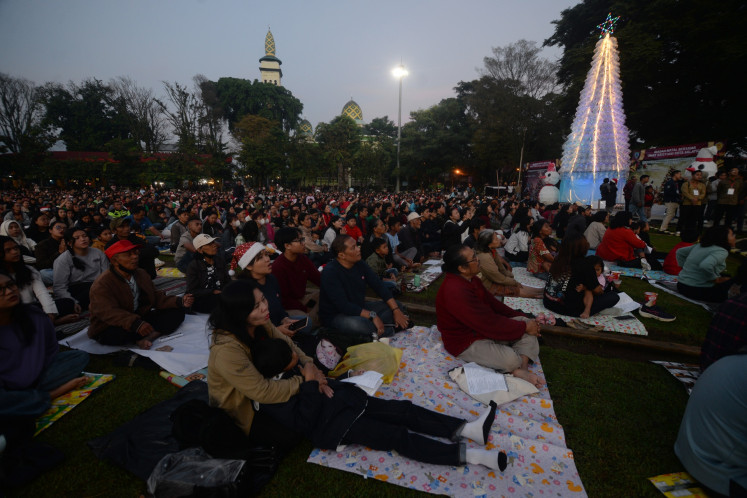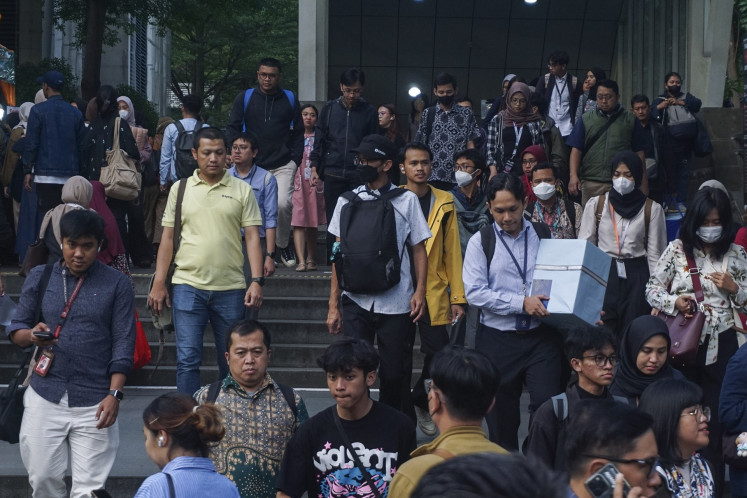Popular Reads
Top Results
Can't find what you're looking for?
View all search resultsPopular Reads
Top Results
Can't find what you're looking for?
View all search resultsUnearthed begonia unravels hidden flora treasure
Up close: Scientist Wisnu Handoyo Ardi of the Center for Plant Conservation at the Indonesian Institute of Sciencesâ Bogor Botanical Garden poses with two new begonia species
Change text size
Gift Premium Articles
to Anyone
U
span class="caption">Up close: Scientist Wisnu Handoyo Ardi of the Center for Plant Conservation at the Indonesian Institute of Sciences' Bogor Botanical Garden poses with two new begonia species.(JP/Indah Setiawati)
The velvety, beautiful and bright foliage of some begonia hybrids usually attracts hobbyists, but a true begonia enthusiast knows the value of various species of more humble appearance that struggle to survive in the wild.
Scientists say many begonia species on islands other than Java remain undiscovered and undocumented. A publication by the European Journal of Taxonomy last December revealed that untapped potential.
Titled Further discoveries in the ever-expanding genus begonia (Begoniaceae): fifteen new species from Sumatra, the article was authored by begonia experts Mark Hughes, from the Royal Botanic Garden Edinburgh; Deden Girmansyah from the Research Center for Biology at the Herbarium Bogoriense; and Wisnu Handoyo Ardi from the Center for Plant Conservation at the Bogor Botanical Gardens.
They found 15 new species during three expeditions in Sumatra between 2008 and 2011. Of those, 13 were described by Hughes and Deden and the remaining two by Wisnu.
'Mark Hughes and Pak Deden previously went to Padang [West Sumatra] and Bengkulu. I only joined the North Sumatra expedition. We went to Simolap village in Mount Leuser National Park in July 2011 and focused on looking for begonia that grew in limestone,' he told The Jakarta Post at the Bogor Botanical Gardens.
Believing that a good mountainous karst area must have limestone begonias, the team set out for 10 days of exploration, going in and out of the forest daily from a nearby basecamp.
Wisnu said ferns like selaginella, better known as spike moss, and elatostema helped the scientists find begonias as they prefer a similarly damp habitat.
The planning all paid off when on the first day, they found two new species growing near each other in dusty soil on a limestone rock. Wisnu named them Begonia olivacea ardi and Begonia simolapensis ardi.
'It was the beginning of the dry season, so the plants were not in a very good condition. However, we still found remains of flowers and fruits, so we could confirm that they were new species,' he said.
The olivacea on display in the Bogor Botanical Gardens had much smaller, cuter leaves than the simolapensis, which had wider, shinier green leaves.
'Olivacea has potential as a decorative plant. This kind of begonia is sought after by collectors because it is rare and hard to find,' Wisnu said.
Begonia simolapensis - Courtesy of LIPI
He said limestone begonias have a very high level of local endemism and limited species distribution.
A begonia species found in one limestone hill is usually not available in another limestone area because the tiny begonia seeds do not travel far. The presence of begonia, which grows on the forest floor, shows that the forests are still in good condition because the plant loves moisture and lots of shade.
Indonesia, a hotspot of diversity for begonia in Asia, is currently home to more than 200 begonia species. There are some 1,600 species spread across Africa, tropical America and tropical Asia.
The discovery of 15 new begonia species in Sumatra indicates that this genus is still underexplored.
Wisnu believes that if such new discoveries become a continuous trend, the number of begonia species in Indonesia could double.
He said even in Bali Botanical Gardens there were a number of begonia species acquired on past expeditions that had not yet been described.
'Unlike orchids, which attract many scientists and lots of research, begonia are not yet explored in Indonesia, while in fact the plant is a great asset for our flora. We have seen massive deforestation, but on the other hand, we only have limited human resources to discover and describe the plant,' he said.
Wisnu said Deden and he were among a handful of Indonesian scientists focusing on begonia taxonomy, along with I Made Ardhaka and Ni Kadek Erosi Undaharta from the Bali Botanical Gardens.
The journal article states that Mt. Leuser National Park is under pressure from illegal logging and land-use changes, while another limestone area in Padang is under threat from mining expansion, which could affect the new begonia found in that area.
According to criteria set by the International Union for the Conservation of Nature, six of the 15 new begonia species are considered 'least concerning', five are 'vulnerable' and four are 'data deficient'.
Hughes, who has been researching begonia for around 15 years, said the balance between keeping habitats pristine and utilizing the natural wealth of Indonesia is something that only the country can decide.
'I think we have to be realistic about conservation,' he said in an email to the Post.
Begonia olivaceae - Courtesy of LIPI
Mining companies, he said, needed to be aware of the impact of their activities and try as much as possible to mitigate it. He said scientists could provide assistance, so communication and collaboration would be the key.
Hughes said the essential aspect of conservation was to know what the country had to conserve, which could only come with continued research of the type carried out by the Herbarium Bogoriense and the Bogor Botanical Gardens to discover and document the country's amazing flora.
Sumatra, in his opinion, is a fascinating island to explore because it has some of the best tropical montane forests in the world.
Hughes said there were many undiscovered begonia species in Sumatra, and it had been an honor for him to collaborate with scientists there.
'Together we have been describing and documenting the wonderful and beautiful begonia of Sumatra ' one small piece in the jigsaw of understanding the stunning natural heritage of Indonesia, which is of global importance.'













